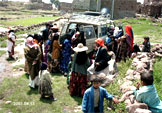
The Ministry of Public Health and Population, Yemen, has tested the use of primary health care (PHC) mobile teams, including IMCI care, in two districts, as a means of providing services to underserved populations. Initial results, reported at the Regional IMCI Coordinators’ Meeting held in Amman this month, are encouraging.
The Ministry of Public Health and Population, Yemen, has tested the use of primary health care (PHC) mobile teams, including IMCI care, in two districts, as a means of providing services to underserved populations. Initial results are encouraging. A number of factors hinder accessibility to health services in many parts of the country, especially in rural areas, where most of the population lives and under-five mortality is higher. Beside economic and social access, geographical access is hampered by a difficult terrain landscape, with mountains, desert and a widely disperse population over a vast area in the country. Utilization of health services is also low. Despite efforts made in the past three years, only about one in four primary health care (PHC) facilities has staff trained in IMCI. Based on the positive experience of outreach services for immunization, four rounds of outreach PHC services were carried out in August 2007 in two districts having a relatively high population and low number of health facilities. Two mobile teams composed of a physician and health worker trained in IMCI, a midwife, EPI and health education staff visited each of the two districts for 5 days. Fig. 1 and 2 show the number of children under-five who received care in the two districts during the visit of the mobile teams and the many conditions that were identified. A higher number of children were seen in these five-day visits of mobile teams than during a period of one month at health facilities (Fig.3). The challenge is to expand this service, sustain it and monitor its effects.





 IMCI pre-service education: guide to evaluation
IMCI pre-service education: guide to evaluation